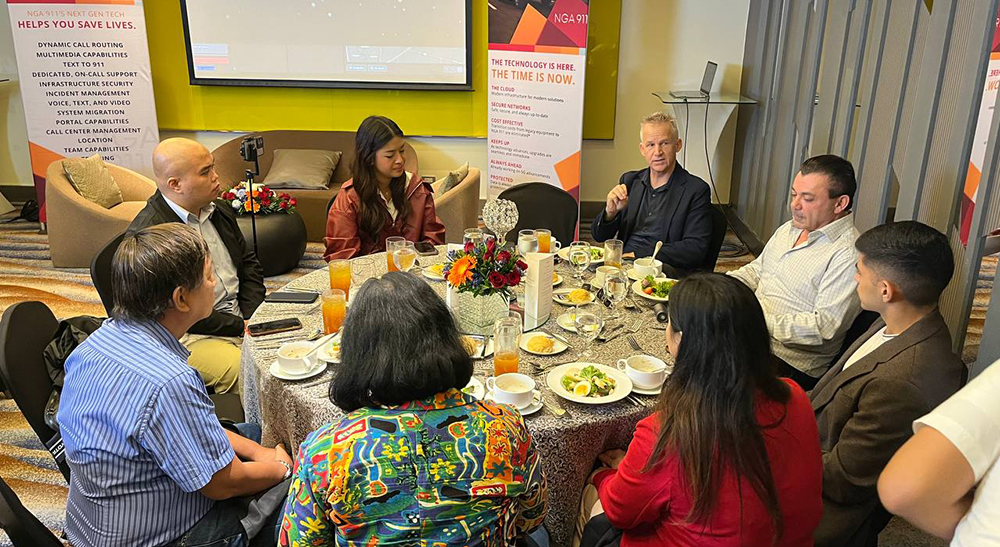By Raine Nakpil
QUEZON CITY (Sept. 15, 2025) — The Philippines entered a new era of public safety with the launch of Next Generation Advanced (NGA) 911, a unified nationwide hotline designed to revolutionize how the country responds to emergencies.
At a media roundtable, NGA founder and CEO Don Ferguson and co-founder and Director for International Sales Mike Amos said the system has already saved lives and transformed response nationwide.
For decades, Filipinos juggled multiple hotlines in moments of crisis, with numbers for police, fire, and rescue varying from one city to another. In those seconds when confusion cost lives, NGA 911 now offers a single reflex: dial 911. “Whether you are four years old or ninety-nine, you know to call 911,” Amos said.
The system goes beyond a call center upgrade. Through the NEXiS Message platform, citizens can send texts, photos, and videos directly to emergency command centers. Calls are pinpointed in seconds using GPS, while faster routing and data-sharing enable police, fire, and medical teams to coordinate like never before.
Because the Philippines adopted NGA only now, Ferguson noted, it benefits from the latest version — newer than what some US states are currently using.

NGA founder and CEO Don Ferguson (clockwise, 1st from the top), as well as co-founder and Director for International Sales Mike Amos (clockwise, 2nd from the top), narrate how the emergency response system has already helped law enforcement agencies solve and even prevent crisis situations. (Photo by Raine Nakpil)
Several local government units (LGUs) have already come online, including Morong in Rizal, Mambajao in Camiguin, Cebu City, Cagayan de Oro, Alaminos in Pangasinan, and Bustos in Bulacan, with Navotas City next in line. Once limited by fragmented systems, these LGUs are now linked to a world-class network certified by the US-based National Emergency Number Association.
The impact is tangible. The first call came from a woman facing a home invasion; police arrived within four minutes to stop the intruder. In another case, a kidnapping victim held for nine days was rescued within two minutes after her captors tried to withdraw ransom at a bank.
Beyond high-profile rescues, the Philippine National Police (PNP) reported that 91 percent of all emergency calls are now answered within five minutes, with average response time down to 3.1 minutes nationwide. Medical experts noted how life-saving such speed could be: for a heart attack patient, three minutes can mean not just survival but reduced permanent damage.
BGen. Warren Tolito, director of the PNP Communications and Electronics Service, cited cases that underscore the change: a woman pulled back from a suicide attempt in Batasan Hills; a newborn abandoned in Laguna rushed to hospital and saved; a tanker hijacking foiled after quick coordination between Caloocan and Obando units.
“This is even better than the States,” said Robert Llaguno, country head of NGA 911 Philippines, noting that calls are picked up in just two rings and dispatches made in less than a minute. He credited not only technology but also improved police morale.
Still, Ferguson and Amos cautioned against abuse. Prank calls, they warned, are not only unethical but dangerous, diverting life-saving resources. Locations are tracked instantly, and pranksters face possible arrest. The system also accommodates non-physical crises, routing calls to mental health professionals when needed.
Behind the rollout is an unusual alliance: the Department of the Interior and Local Government, the Bureau of Fire Protection, PLDT, Globe, Smart, DITO, and NGA 911. Hosted on ePLDT’s Pilipinas Cloud and Amazon Web Services, the infrastructure is designed to withstand both disasters and cyberthreats.
Launched under President Ferdinand Marcos Jr.’s Bagong Pilipinas initiative, the Unified 911 replaced more than 30 fragmented hotlines with one reliable number. DILG Secretary Juanito Victor Remulla called it a “comprehensive strategy” built on technology, data-driven analytics, and rigorous training to modernize the nation’s emergency response.
For Ferguson and Amos, the goal is cultural instinct. The number must be visible on signs, taught in classrooms, ingrained in daily life. In the end, they said, the difference between tragedy and survival often comes down to reflex.
Emergencies will never wait. With NGA 911, neither will the Philippines.




